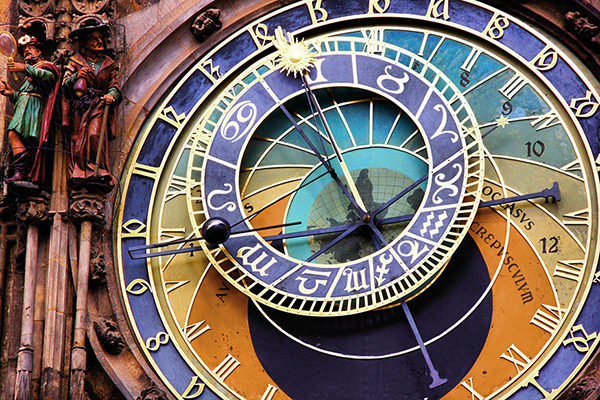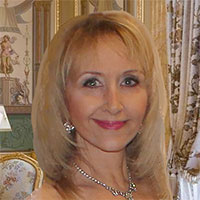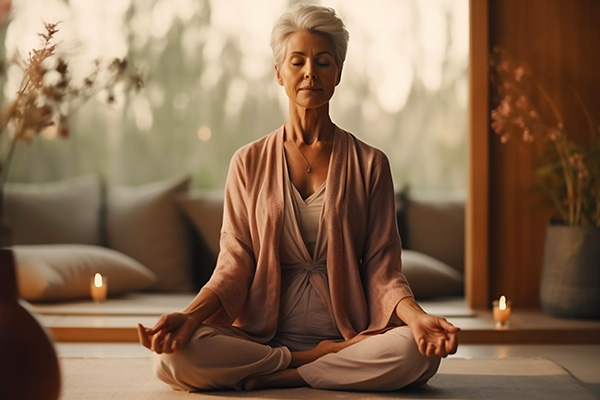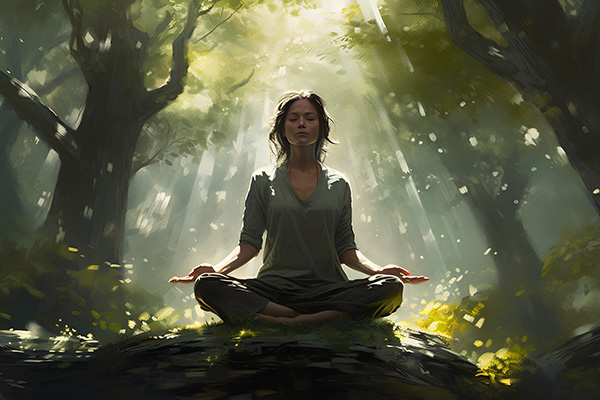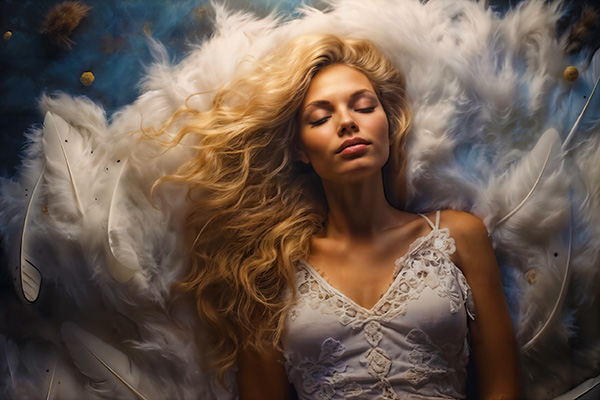Discover How to Conduct a Samhain Ceremony for Self-Transformation
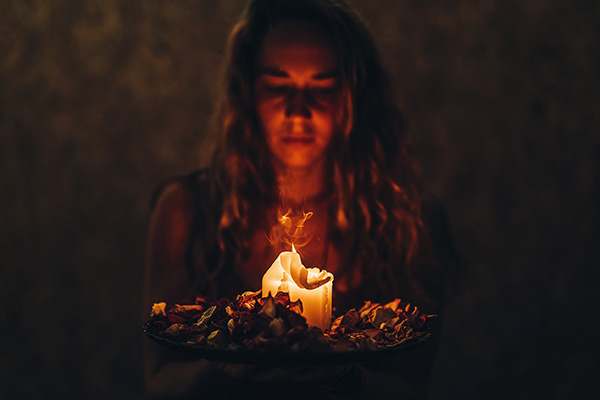 One of the most enchanted and energetically vibrant moments in the metaphysical calendar returns once again tomorrow. Samhain, often referred to as the Celtic New Year, is a revered festival observed on October 31st.
One of the most enchanted and energetically vibrant moments in the metaphysical calendar returns once again tomorrow. Samhain, often referred to as the Celtic New Year, is a revered festival observed on October 31st.
Samhain symbolizes the conclusion of the harvest season and the advent of winter. It provides a moment to pay tribute to our ancestors, reflect on the thinning barrier between the physical and spirit worlds, and establish intentions for the upcoming annual cycle.
Samhain is especially meaningful for those attuned to the rhythms of nature and the spirit realms. Historically, it was believed that the distinctions between the physical and spiritual realms were most fragile on this sacred night.
The Celts and Norse regarded this period as a unique opportunity to connect with ancestors, departed loved ones, and the deities, gaining insights for the future. For the Vikings and other Northern European groups, Samhain also served as a moment for divination. Runes, symbols of universal wisdom, were frequently utilized to gain foresight into the forthcoming year.
This year, Samhain bears an exceptionally potent energy as it aligns with the Waning Crescent Moon moving from Libra to Scorpio. This final lunar phase before renewal prompts us to release what is no longer beneficial, and its transition from the balanced, harmonious energies of Libra to the intense, transformative depths of Scorpio will enhance this process.
The influence of Libra invites contemplation regarding relationships, internal equilibrium, and the necessity for harmony, while Scorpio’s energy pushes us towards deeper reflection, emotional metamorphosis, and embracing the enigmas of life, death, and rebirth.
Ah, beautiful October, as you herald the season that awakens my spirit, your magnificent splendor lifts my soul like a leaf dancing in an autumn breeze and makes my heart sing like a celestial choir ~ Peggy Toney Horton
This cosmic alignment sets the perfect stage for delving into spiritual endeavors this Samhain, connecting with spirit and the unseen realms while establishing powerful intentions for personal and emotional transformation as we transition into the Celtic New Year. It is an auspicious moment for releasing, introspection, and preparing for new beginnings.
A wonderful way to maximize this transformative energy is by conducting a Samhain ritual tomorrow night. Rituals yield their greatest strength when executed after sundown, as the night deepens and the barrier between worlds is most permeable. If you prefer to synchronize with lunar timing, you can check your local moonrise schedule.
Here is a guide to crafting a simple yet profound ritual to honor this sacred evening.
PREPARATION
To fully harness the transformative potential of Samhain, take the time to create a ritual space that facilitates your connection to the energies of release, renewal, and spiritual guidance.
What you’ll require:
– A serene, private ritual space, ideally an outdoor area with fresh air or near a window with a natural view.
– A candle (black or white is preferable for Samhain)
– A sheet of paper and a pen
– Fireproof container such as a metal or ceramic bowl, kettle, or heat-resistant dish
– A small offering like dried herbs, flowers, or a piece of fruit
– A rune stone or image of the Raidho rune
– Incense, such as sage, mugwort, or frankincense, to cleanse the environment
The inclusion of the Raidho rune is significant as it embodies journey, transformation, and spiritual alignment, making it a potent representation for reflection and intention setting. The transformative energy of Samhain paired with the waning crescent moon in Scorpio encourages us to deeply contemplate our lives while fostering readiness for fresh starts.
The presence of the Raidho rune enhances this theme, symbolizing not only physical travels but also the inner journey of growth, change, and spiritual alignment. By embracing the energy of Raidho, you harmonize with the universe’s rhythm and the subsequent steps on your path. Raidho directs us along the suitable course and urges us to actively pursue the transformations we desire.
The moon hangs low above the trees, above the world; a reminder that there is light in darkness and darkness in light, and that everything that was will be again ~ S.R. Hardy
CLEANSING AND SHIELDING
Before initiating your Samhain ritual, it’s crucial to cleanse your ritual space and establish a protective shield around you. Start by lighting your incense and letting the smoke purify the air. As the smoke ascends, visualize it removing any lingering negative or stagnant energies, leaving the space open and clear for your ritual work. As you breathe deeply, sense your body and mind beginning to relax, grounding you in the current moment.
Once the area feels clear, take a moment to envisage a protective shield enveloping you. Close your eyes and picture a radiant, glowing light – white, gold, or violet – forming a protective bubble or sphere surrounding your being. Visualize this light expanding outward, encapsulating the entire ritual space. This shield serves as a barrier against unwanted energies or influences, permitting only positive and loving energies to enter.
You may also invite your guides, ancestors, the angels, or the Goddess Freya to assist with this protection by requesting her presence to oversee and guide you throughout the ritual.
Once you feel anchored and shielded, concentrate on setting your intention for the ritual, knowing you are energetically safeguarded. Keep your shield active during the ritual, ensuring you are enveloped in safety and clarity as you navigate through the various phases of your Samhain practice. If you sense an energetic shift at any point, pause to reinforce your protective barrier by envisioning the light intensifying and brightening, anchoring your space in peace and security.
CANDLE MEDITATION
The next stage involves a candle meditation, symbolizing the illumination of your path ahead. When lighting the candle—whether black to signify protection and release, or white for clarity and new beginnings—let its flame become the focal point of your meditation. The flickering light represents not only the guiding flame of your inner wisdom, but also the energies of transformation and renewal that Samhain offers.
Then, grasp the Raidho rune, holding it gently in both hands. Allow the rune’s energy to steer your thoughts and intentions for the forthcoming year. What personal evolution do you aspire to achieve? What journey do you envision taking?
Take a deep breath, center yourself, and softly gaze into the candle flame. As you focus on the flame, begin to contemplate the past year. Allow your mind to gently review the significant moments – both joyful and tough – that have influenced your journey. Acknowledge the experiences, habits, or relationships that may have once been beneficial but now feel burdensome or stagnant. This is the moment to discern what you are equipped to release to create space for new growth.
As you hold these reflections in your mind, visualize the flame consuming any lingering ties to these past aspects. Imagine the candlelight illuminating the areas of your life that require healing and closure. Allow yourself to sit with any feelings that arise, understanding that this release process is vital to making way for the future. You might choose to silently name the habits or situations you are ready to relinquish and present them to the flame as it flickers.
With every exhale, visualize yourself relinquishing the past – old energies, patterns, or blockages – dissolving into the candle’s light. Trust that as the candle burns, it purifies and transforms the energies surrounding you. This symbolic act of illumination prepares you to welcome the changes that lie ahead, creating a space for clarity, renewal, and the potentialities of the new year.
Before concluding the meditation, take a moment to envision the candle’s light growing ever brighter and stronger, expanding to illuminate your path ahead. Feel its warmth guiding you towards new opportunities and personal transformation, filling you with a sense of purpose and direction. As the candle continues to burn, know that you are gracefully letting go of the past and stepping into the next chapter of your journey.
The pagan Samhain is neither bad nor negative. It has always been a time to reaffirm our belief in the unity of all spirits, and our steadfast commitment that physical death is not the ultimate conclusion of existence ~ Edain McCoy
INTENTION-SETTING
Establish your intentions to align with the transformations or manifestations you wish to welcome into your life. Start by holding the paper and sensing the weight of your intentions as you prepare to articulate them. Take a moment to center yourself and attune with your inner desires and the inspiration of the Raidho rune, which signifies forward movement, journeys, and spiritual alignment.
As you write each of your intentions down, be precise and specific about what you aim to manifest or transform in the upcoming year. Your intention can pertain to personal development, relationships, health, spiritual advancement, career, or any other aspect of your life where you yearn for change. Avoid ambiguous language; instead, articulate your intention with certainty and conviction, knowing that the Universe is attentive.
For instance, if you seek increased abundance, you could write, “I welcome prosperity and financial growth into my life in the coming year, and I embrace the opportunities that will lead me there. If you desire healing, say, “I let go of past wounds and welcome emotional healing, advancing with strength and clarity.” Visualize yourself already living in harmony with this intention and experiencing the joy, peace, or fulfillment it will provide.
OFFERING AND RELEASE
After recording your intentions, place the paper beside your candle and the Raidho rune, allowing their energies to amplify your wishes. Now present the gift of dried herbs, flowers, or fruit in gratitude to the spirit realm and your higher power. This act of offering signifies a gesture of appreciation to the sacred forces that guide and protect you. Feel the flow of energy between you and the Universe – your intention is not merely a wish, but a seed you are planting in the fertile ground of the cosmos.
Now comes the symbolic release of your intention. Safely burn the paper in the candle’s flame. Light the paper cautiously, keeping your hands at a safe distance from the fire. As it burns, remain mindful and vigilant, watching until it is entirely reduced to ash. Have some water, sand, or even a small fire extinguisher on hand, just in case. Once the paper has completely burned, let the ashes cool before handling or disposing of them.
As the paper turns to ash, visualize your intention being lifted by the smoke, sent out into the cosmos, where it will take root and flourish. The fire element transforms your written words into energy, boosting your desire and sending it forth into the universe.
If burning is not practical, you can bury the paper outdoors. As you cover it with soil, envision your intention as a seed that will sprout and thrive over time, nourished by nature’s elements and your own devotion.
Whether by fire or earth, this act represents the release and surrender of your intention, trusting that it will develop and manifest in divine timing. Understand that you’ve planted the seed with care and that the energy of Raidho will navigate you on your journey, helping you proceed with confidence and clarity. Your intention is now entrusted to the universe, ready to unfold as you continue on your path.
CLOSING
Finally, express gratitude to the ancestors, guides, angels, or deities who were present during your ritual. Take a moment to feel the serene power of the waning crescent and trust that your intention will flourish in harmony with divine timing. Extinguish the candle, having faith in the inspiration of Raidho as you journey onward.
Samhain serves as a reminder that all existence operates in cycles – birth, death, and rebirth. As you let go of the past and greet the new, trust that you are supported by the wisdom of your ancestors and the universe’s energies. Commemorate this Samhain with an open heart, confident that you are on the right path and that the universe is guiding your steps.
|
Runa is a reader with exceptional abilities and embodies a gift that continuously benefits others and her community. She possesses spiritual, artistic, and creative talents, nurturing her spirit through selfless work with incarcerated youth and through her reading practice in Germany and with clients around the globe. A Rune expert, Reiki Master, and gifted oracle reader, Runa is perpetually accompanied by her Northern Light Guides during every reading. With her compassionate, straightforward insights and non-judgmental readings, she provides positive energy that alleviates burdens and unveils pathways to future aspirations. Since early on, she could read the energies surrounding her; however, her study of ancient runes and symbols opened a treasure chest of answers to assist and direct others along their journey. Runa has read for over 20,000 clients from all walks of life, including numerous corporate clients. She operates her own reading practice in Germany, where she resides with her husband and cherished cat, “Monster.” For more than 15 years, she has inspired, enriched, and empowered the lives of adults and teens, encouraging them to courageously embrace and express themselves to achieve their ambitions. If you wish to receive a reading from this remarkable Rune goddess, you can find Runa at PsychicAccess.com |
Samhain, commonly known as Halloween or the Celtic New Year, is a holy occasion that signifies the conclusion of the harvest season and the start of winter. It is a time when the barrier between the physical and spiritual realms is considered to be at its weakest, creating an ideal opportunity for personal evolution and spiritual advancement. If you are interested in tapping into the energy of this influential time, understanding how to perform a Samhain ritual can provide a transformative experience.
1. Set your intention:
Before initiating any ritual, it is crucial to define your intention. Spend some time contemplating what you wish to accomplish or release during this ritual. Are you in pursuit of personal growth, healing, or discarding something that no longer benefits you? Clarifying your intention will aid in directing your ritual and focusing your energy.
2. Create a sacred space:
Find a quiet and comfortable location where you can carry out your ritual without interruptions. Clear the area of any clutter and establish an altar or sacred space using items that hold personal importance to you. This could include candles, crystals, seasonal symbols, or any other objects that resonate with your intention.
3. Honor the ancestors:
Samhain is a time when the boundary between the living and the deceased is believed to be at its most fragile. Take a moment to honor your ancestors and loved ones who have passed. Light a candle or place a photograph or memento on your altar to signify their presence. Express gratitude for their guidance and protection.
4. Release what no longer serves you:
Samhain is a period for letting go and discarding old patterns. Take a piece of paper and pen down anything you wish to release from your life. This could include negative emotions, limiting beliefs, or unhealthy habits. After writing them down, read them aloud and visualize their departure from your life. Burn the paper in a fireproof container, symbolizing the release of these burdens.
5. Embrace the darkness:
As the days diminish and darkness prevails, Samhain invites us to embrace the shadows within ourselves. Take a moment to reflect on your own shadow aspects – the parts of yourself that you may have overlooked or denied. Light a black candle to signify the darkness and meditate on these aspects. Embrace them with love and acceptance, realizing that they form an integral part of your holistic self.
6. Set intentions for the future:
Samhain is not only a time for reflection but for establishing intentions for the future. Visualize your goals and aspirations. Document them on a separate piece of paper and place it on your altar. Light a white candle to symbolize the illumination guiding you toward these intentions. As you proceed, feel the transformative energy and renewal flowing through you.
7. Express gratitude:
Before concluding your ritual, take a moment to express gratitude for the blessings in your life. Offer thanks for the lessons acquired, the growth experienced, and the guidance received. Engage with the energy of gratitude and let it fill your heart.
Keep in mind, a Samhain ritual is a personal and sacred experience. Feel free to alter it according to your beliefs and preferences. The key is to approach it with an open heart and a readiness to embrace personal transformation. As you engage in this ritual, may you discover the strength, clarity, and renewal you seek on your spiritual journey. Continue reading


